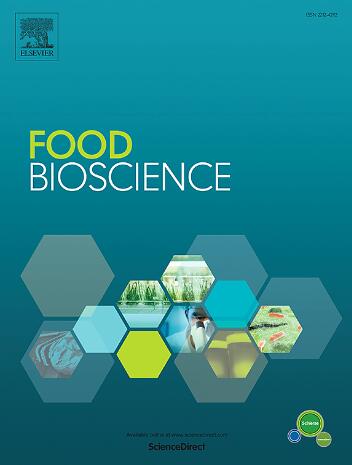Weissella cibaria X1发酵通过代谢调节提高红花(Carthamus tintorius L.)降ua能力
IF 5.9
1区 农林科学
Q1 FOOD SCIENCE & TECHNOLOGY
引用次数: 0
摘要
利用尿酸降解菌Weissella cibaria X1进行红花(Carthamus tinctorius L.)发酵。在高尿酸血症(HUA)斑马鱼模型中,与自然发酵红花相比,X1发酵红花的抗氧化能力和黄嘌呤氧化酶(XO)抑制率显著提高,UA水平降低81.30%,XO活性降低99.02%,肌酐水平降低27.08%。上调UA合成-次黄嘌呤-鸟嘌呤磷酸化酰基转移酶1 (HPRT1基因)1.91倍,促进UA排泄-尿酸氧化酶(UOX)基因5.40倍,有机阴离子转运蛋白1 (OAT1)基因4.80倍,肝细胞核因子4 α (HNF4A基因)3.29倍,多价PDZ结构域1 (PDZK1)基因57.46倍。随后,非靶向代谢组学分析表明,X1发酵与自然发酵相比,降低了l -谷氨酰胺含量,调节了嘌呤代谢,从而降低了嘌呤水平,增加了甜菊苷水平。我们的研究为HUA提供了一种潜在的药物和营养治疗策略。本文章由计算机程序翻译,如有差异,请以英文原文为准。
Weissella cibaria X1 fermentation enhances the UA-lowering ability of Carthamus tinctorius L. via metabolic regulation
The uric acid (UA) degrading Weissella cibaria X1 was employed for the fermentation of safflower (Carthamus tinctorius L.). Compared with naturally fermented safflower, X1 fermented safflower significantly enhancing the antioxidant capacity and xanthine oxidase (XO) inhibition rate, decreased UA levels by 81.30 %, XO activity by 99.02 %, and creatinine levels by 27.08 % based on a hyperuricemia (HUA) zebrafish model. Additionally, it upregulated the genes inhibiting UA synthesis—hypoxanthine-guanine phosphoribosyltransferase 1 (HPRT1 gene) 1.91 fold, and those promoting UA excretion—urate oxidase (UOX) gene 5.40 fold, organic anion transporter 1 (OAT1) gene 4.80 fold, hepatocyte nuclear factor 4 alpha (HNF4A gene) 3.29 fold, and polyvalent PDZ domain 1 (PDZK1) gene 57.46 fold. Subsequently, non-targeted metabolomics analysis showed that X1 fermentation downregulated the content of L-glutamine and modulated purine metabolism than the safflower fermented naturally, thus decreasing the levels of purines and increasing those of scolymoside. Our research provided a potential HUA therapy via both pharmaceutical and nutraceutical strategies.
求助全文
通过发布文献求助,成功后即可免费获取论文全文。
去求助
来源期刊

Food Bioscience
Biochemistry, Genetics and Molecular Biology-Biochemistry
CiteScore
6.40
自引率
5.80%
发文量
671
审稿时长
27 days
期刊介绍:
Food Bioscience is a peer-reviewed journal that aims to provide a forum for recent developments in the field of bio-related food research. The journal focuses on both fundamental and applied research worldwide, with special attention to ethnic and cultural aspects of food bioresearch.
 求助内容:
求助内容: 应助结果提醒方式:
应助结果提醒方式:


